Project Risk, Finance, and Monitoring Report for Apple Inc. MBA643
VerifiedAdded on 2022/11/11
|14
|2834
|141
Report
AI Summary
This report, prepared for an MBA course, analyzes project risk management and financial aspects, focusing on Apple Inc. The report starts with an executive summary and includes an analysis of project selection methods (Payback Period), cost management strategies, and funding sources. It explores internal and external financing options and recommends internal sources like retained earnings for Apple. The report also covers implementation and winding-up issues. Part B conducts a capital budgeting analysis, including the calculation of future cash flows, Net Present Value (NPV), and a discussion on the cost of equity financing. The analysis concludes with recommendations for project investment based on the NPV results, considering the time value of money and the potential benefits to the company. The report provides a detailed examination of financial principles and their application in a real-world business scenario.

Project Risk, finance, and monitoring
Paraphrase This Document
Need a fresh take? Get an instant paraphrase of this document with our AI Paraphraser
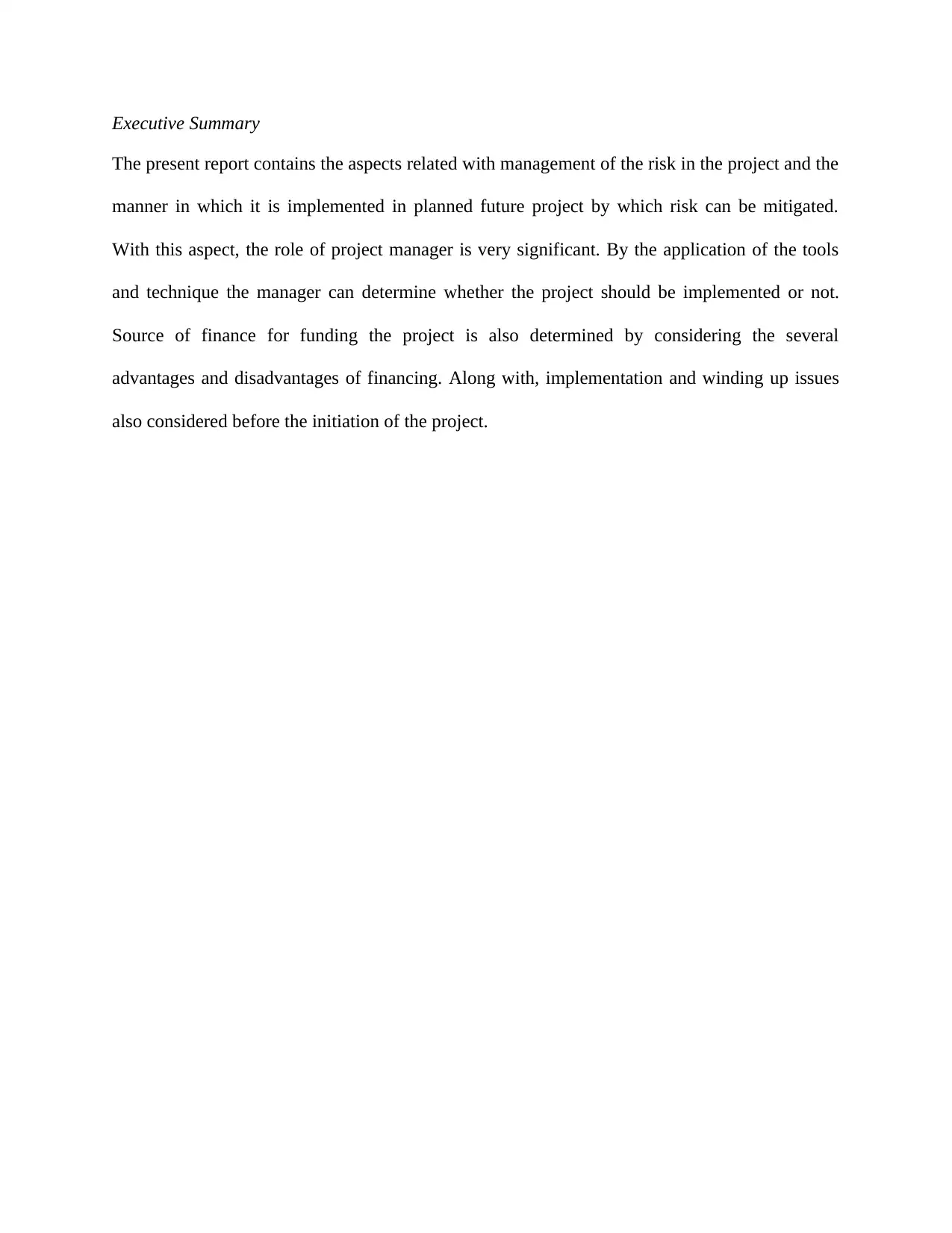
Executive Summary
The present report contains the aspects related with management of the risk in the project and the
manner in which it is implemented in planned future project by which risk can be mitigated.
With this aspect, the role of project manager is very significant. By the application of the tools
and technique the manager can determine whether the project should be implemented or not.
Source of finance for funding the project is also determined by considering the several
advantages and disadvantages of financing. Along with, implementation and winding up issues
also considered before the initiation of the project.
The present report contains the aspects related with management of the risk in the project and the
manner in which it is implemented in planned future project by which risk can be mitigated.
With this aspect, the role of project manager is very significant. By the application of the tools
and technique the manager can determine whether the project should be implemented or not.
Source of finance for funding the project is also determined by considering the several
advantages and disadvantages of financing. Along with, implementation and winding up issues
also considered before the initiation of the project.
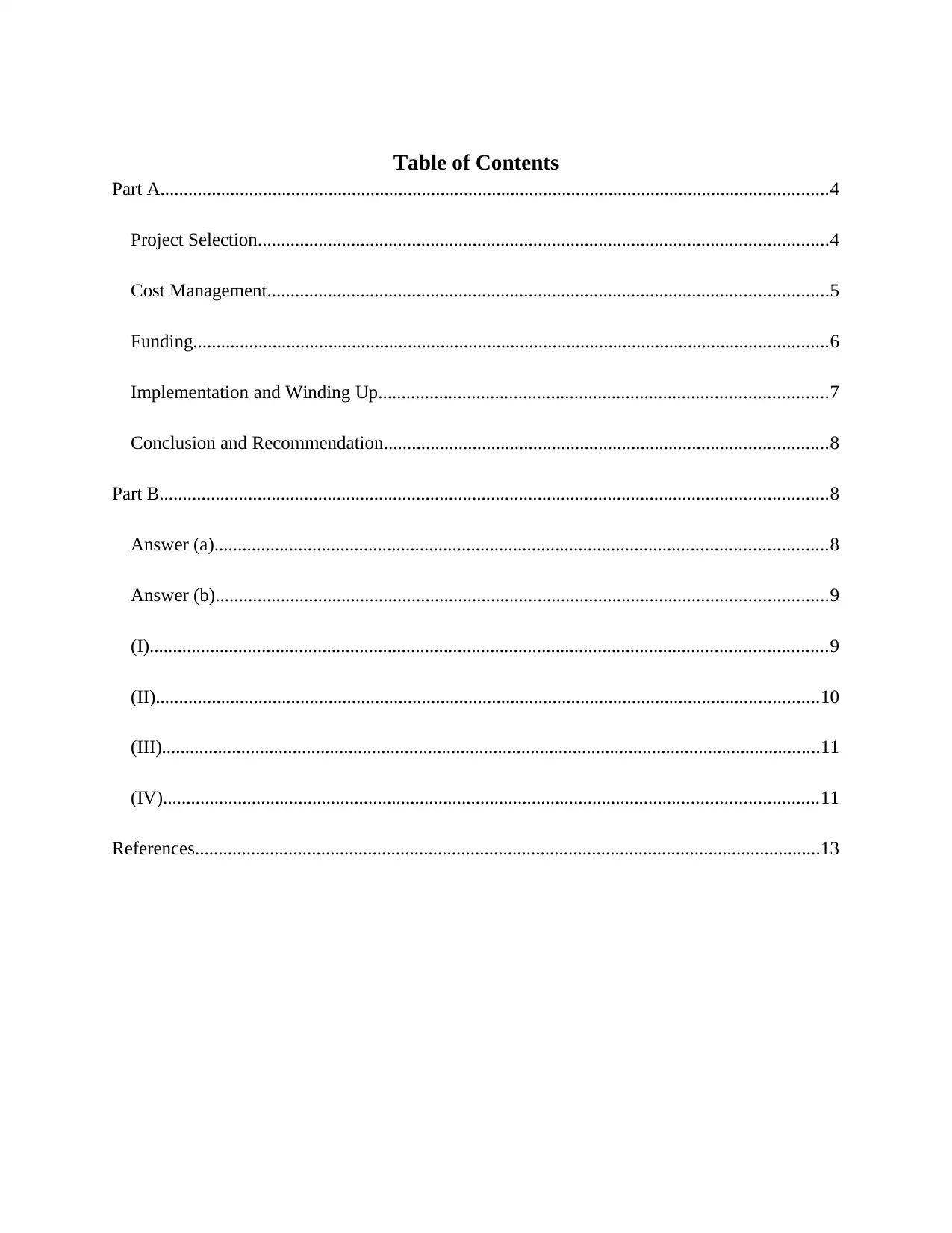
Table of Contents
Part A...............................................................................................................................................4
Project Selection..........................................................................................................................4
Cost Management........................................................................................................................5
Funding........................................................................................................................................6
Implementation and Winding Up................................................................................................7
Conclusion and Recommendation...............................................................................................8
Part B...............................................................................................................................................8
Answer (a)...................................................................................................................................8
Answer (b)...................................................................................................................................9
(I).................................................................................................................................................9
(II)..............................................................................................................................................10
(III).............................................................................................................................................11
(IV)............................................................................................................................................11
References......................................................................................................................................13
Part A...............................................................................................................................................4
Project Selection..........................................................................................................................4
Cost Management........................................................................................................................5
Funding........................................................................................................................................6
Implementation and Winding Up................................................................................................7
Conclusion and Recommendation...............................................................................................8
Part B...............................................................................................................................................8
Answer (a)...................................................................................................................................8
Answer (b)...................................................................................................................................9
(I).................................................................................................................................................9
(II)..............................................................................................................................................10
(III).............................................................................................................................................11
(IV)............................................................................................................................................11
References......................................................................................................................................13
⊘ This is a preview!⊘
Do you want full access?
Subscribe today to unlock all pages.

Trusted by 1+ million students worldwide
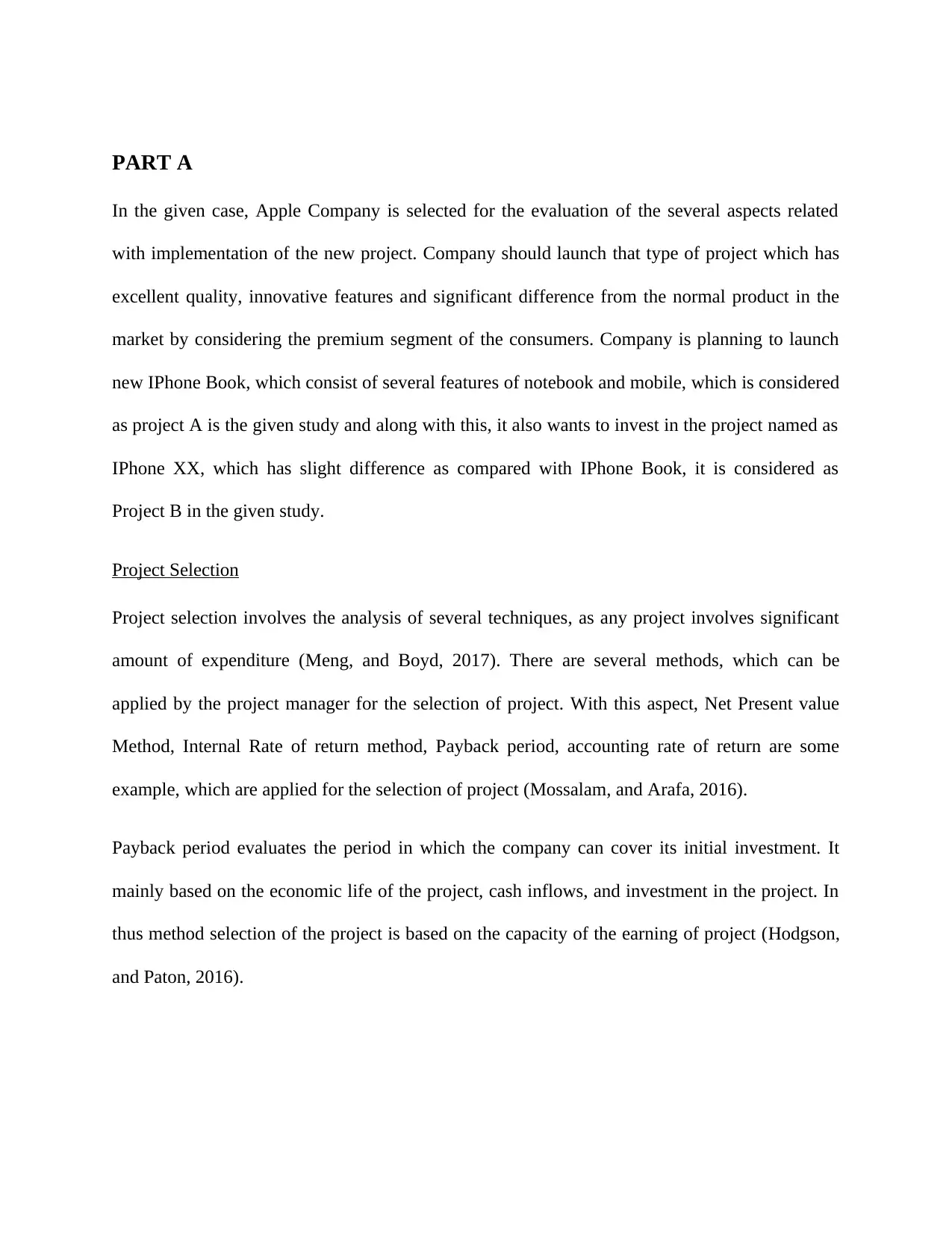
PART A
In the given case, Apple Company is selected for the evaluation of the several aspects related
with implementation of the new project. Company should launch that type of project which has
excellent quality, innovative features and significant difference from the normal product in the
market by considering the premium segment of the consumers. Company is planning to launch
new IPhone Book, which consist of several features of notebook and mobile, which is considered
as project A is the given study and along with this, it also wants to invest in the project named as
IPhone XX, which has slight difference as compared with IPhone Book, it is considered as
Project B in the given study.
Project Selection
Project selection involves the analysis of several techniques, as any project involves significant
amount of expenditure (Meng, and Boyd, 2017). There are several methods, which can be
applied by the project manager for the selection of project. With this aspect, Net Present value
Method, Internal Rate of return method, Payback period, accounting rate of return are some
example, which are applied for the selection of project (Mossalam, and Arafa, 2016).
Payback period evaluates the period in which the company can cover its initial investment. It
mainly based on the economic life of the project, cash inflows, and investment in the project. In
thus method selection of the project is based on the capacity of the earning of project (Hodgson,
and Paton, 2016).
In the given case, Apple Company is selected for the evaluation of the several aspects related
with implementation of the new project. Company should launch that type of project which has
excellent quality, innovative features and significant difference from the normal product in the
market by considering the premium segment of the consumers. Company is planning to launch
new IPhone Book, which consist of several features of notebook and mobile, which is considered
as project A is the given study and along with this, it also wants to invest in the project named as
IPhone XX, which has slight difference as compared with IPhone Book, it is considered as
Project B in the given study.
Project Selection
Project selection involves the analysis of several techniques, as any project involves significant
amount of expenditure (Meng, and Boyd, 2017). There are several methods, which can be
applied by the project manager for the selection of project. With this aspect, Net Present value
Method, Internal Rate of return method, Payback period, accounting rate of return are some
example, which are applied for the selection of project (Mossalam, and Arafa, 2016).
Payback period evaluates the period in which the company can cover its initial investment. It
mainly based on the economic life of the project, cash inflows, and investment in the project. In
thus method selection of the project is based on the capacity of the earning of project (Hodgson,
and Paton, 2016).
Paraphrase This Document
Need a fresh take? Get an instant paraphrase of this document with our AI Paraphraser
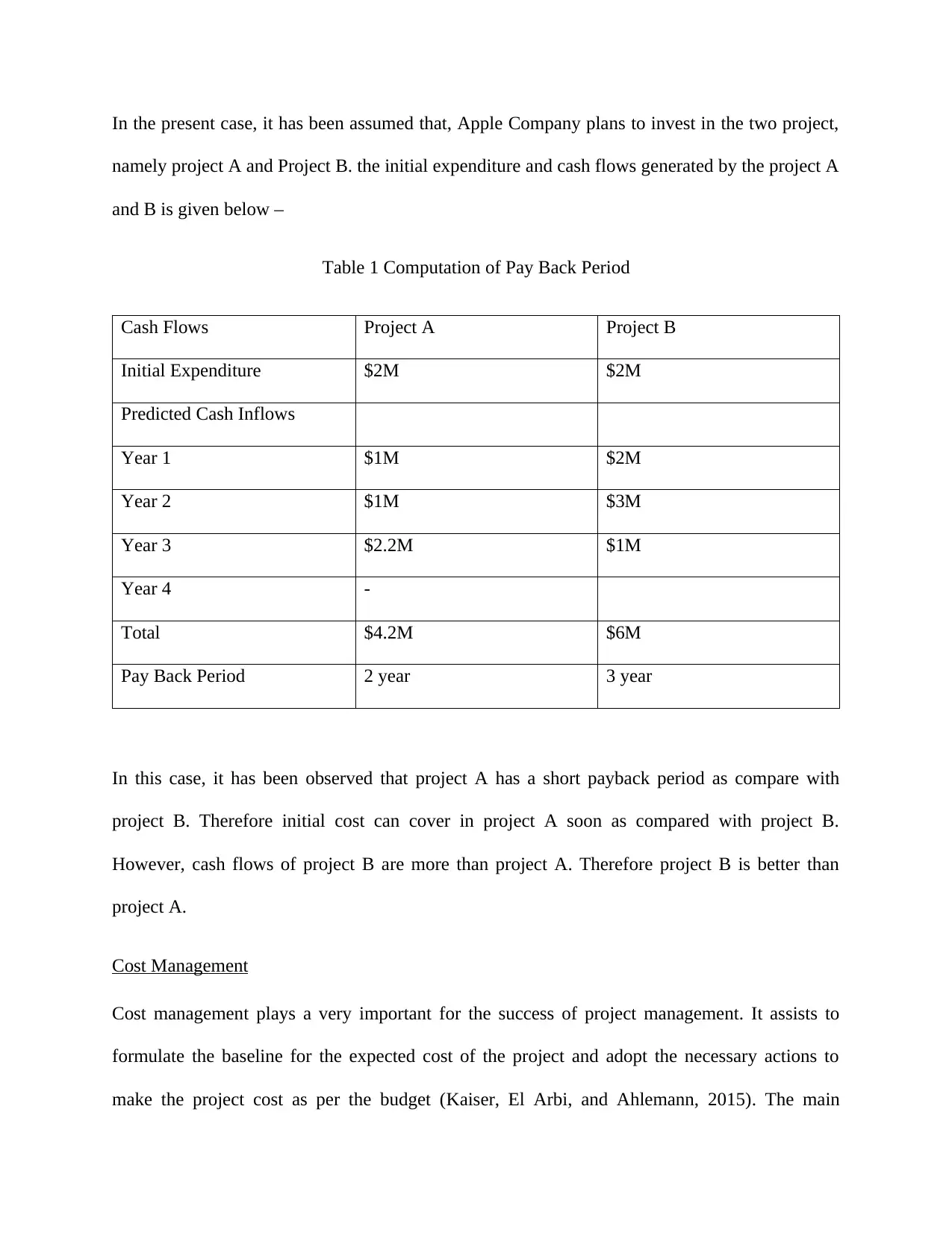
In the present case, it has been assumed that, Apple Company plans to invest in the two project,
namely project A and Project B. the initial expenditure and cash flows generated by the project A
and B is given below –
Table 1 Computation of Pay Back Period
Cash Flows Project A Project B
Initial Expenditure $2M $2M
Predicted Cash Inflows
Year 1 $1M $2M
Year 2 $1M $3M
Year 3 $2.2M $1M
Year 4 -
Total $4.2M $6M
Pay Back Period 2 year 3 year
In this case, it has been observed that project A has a short payback period as compare with
project B. Therefore initial cost can cover in project A soon as compared with project B.
However, cash flows of project B are more than project A. Therefore project B is better than
project A.
Cost Management
Cost management plays a very important for the success of project management. It assists to
formulate the baseline for the expected cost of the project and adopt the necessary actions to
make the project cost as per the budget (Kaiser, El Arbi, and Ahlemann, 2015). The main
namely project A and Project B. the initial expenditure and cash flows generated by the project A
and B is given below –
Table 1 Computation of Pay Back Period
Cash Flows Project A Project B
Initial Expenditure $2M $2M
Predicted Cash Inflows
Year 1 $1M $2M
Year 2 $1M $3M
Year 3 $2.2M $1M
Year 4 -
Total $4.2M $6M
Pay Back Period 2 year 3 year
In this case, it has been observed that project A has a short payback period as compare with
project B. Therefore initial cost can cover in project A soon as compared with project B.
However, cash flows of project B are more than project A. Therefore project B is better than
project A.
Cost Management
Cost management plays a very important for the success of project management. It assists to
formulate the baseline for the expected cost of the project and adopt the necessary actions to
make the project cost as per the budget (Kaiser, El Arbi, and Ahlemann, 2015). The main
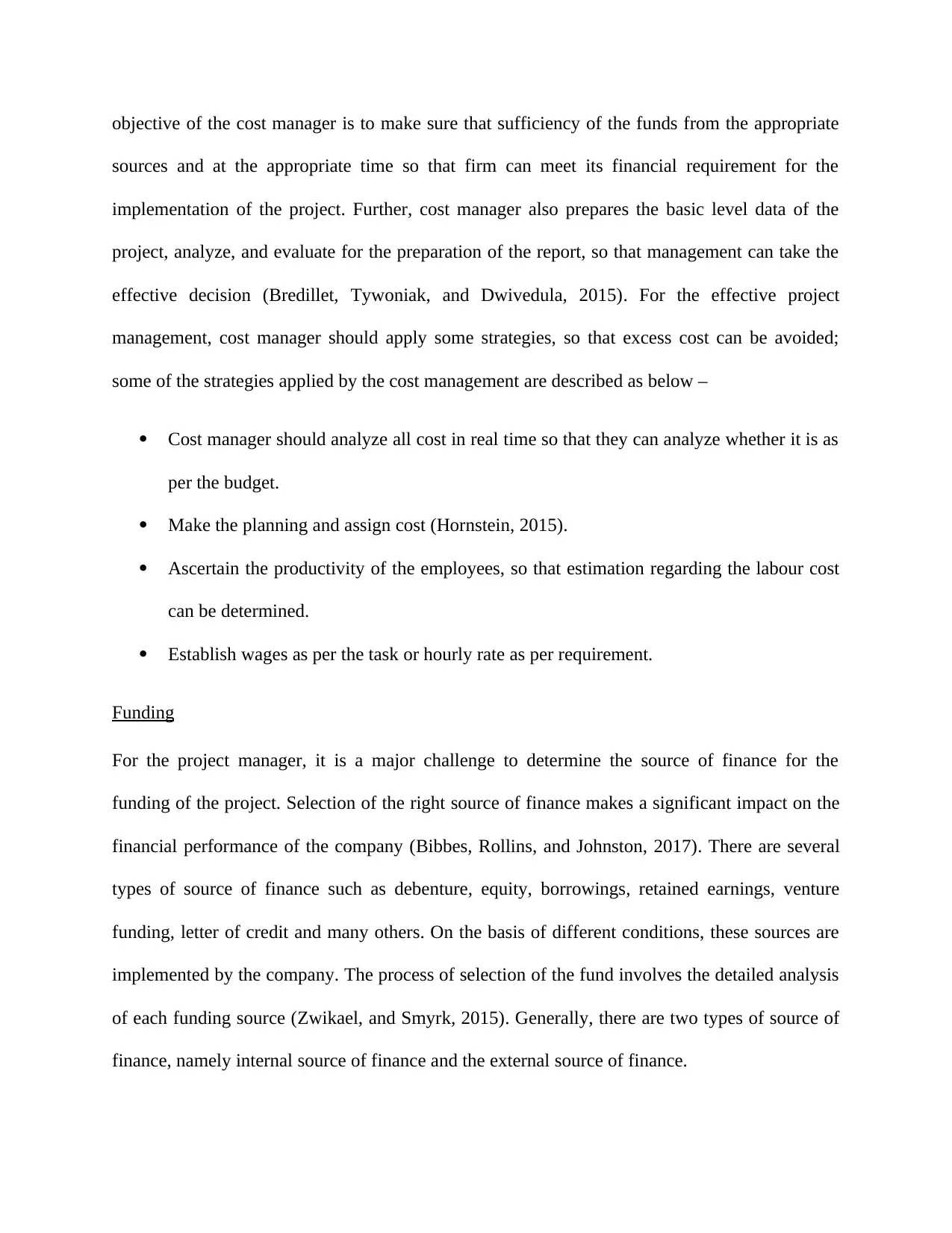
objective of the cost manager is to make sure that sufficiency of the funds from the appropriate
sources and at the appropriate time so that firm can meet its financial requirement for the
implementation of the project. Further, cost manager also prepares the basic level data of the
project, analyze, and evaluate for the preparation of the report, so that management can take the
effective decision (Bredillet, Tywoniak, and Dwivedula, 2015). For the effective project
management, cost manager should apply some strategies, so that excess cost can be avoided;
some of the strategies applied by the cost management are described as below –
Cost manager should analyze all cost in real time so that they can analyze whether it is as
per the budget.
Make the planning and assign cost (Hornstein, 2015).
Ascertain the productivity of the employees, so that estimation regarding the labour cost
can be determined.
Establish wages as per the task or hourly rate as per requirement.
Funding
For the project manager, it is a major challenge to determine the source of finance for the
funding of the project. Selection of the right source of finance makes a significant impact on the
financial performance of the company (Bibbes, Rollins, and Johnston, 2017). There are several
types of source of finance such as debenture, equity, borrowings, retained earnings, venture
funding, letter of credit and many others. On the basis of different conditions, these sources are
implemented by the company. The process of selection of the fund involves the detailed analysis
of each funding source (Zwikael, and Smyrk, 2015). Generally, there are two types of source of
finance, namely internal source of finance and the external source of finance.
sources and at the appropriate time so that firm can meet its financial requirement for the
implementation of the project. Further, cost manager also prepares the basic level data of the
project, analyze, and evaluate for the preparation of the report, so that management can take the
effective decision (Bredillet, Tywoniak, and Dwivedula, 2015). For the effective project
management, cost manager should apply some strategies, so that excess cost can be avoided;
some of the strategies applied by the cost management are described as below –
Cost manager should analyze all cost in real time so that they can analyze whether it is as
per the budget.
Make the planning and assign cost (Hornstein, 2015).
Ascertain the productivity of the employees, so that estimation regarding the labour cost
can be determined.
Establish wages as per the task or hourly rate as per requirement.
Funding
For the project manager, it is a major challenge to determine the source of finance for the
funding of the project. Selection of the right source of finance makes a significant impact on the
financial performance of the company (Bibbes, Rollins, and Johnston, 2017). There are several
types of source of finance such as debenture, equity, borrowings, retained earnings, venture
funding, letter of credit and many others. On the basis of different conditions, these sources are
implemented by the company. The process of selection of the fund involves the detailed analysis
of each funding source (Zwikael, and Smyrk, 2015). Generally, there are two types of source of
finance, namely internal source of finance and the external source of finance.
⊘ This is a preview!⊘
Do you want full access?
Subscribe today to unlock all pages.

Trusted by 1+ million students worldwide
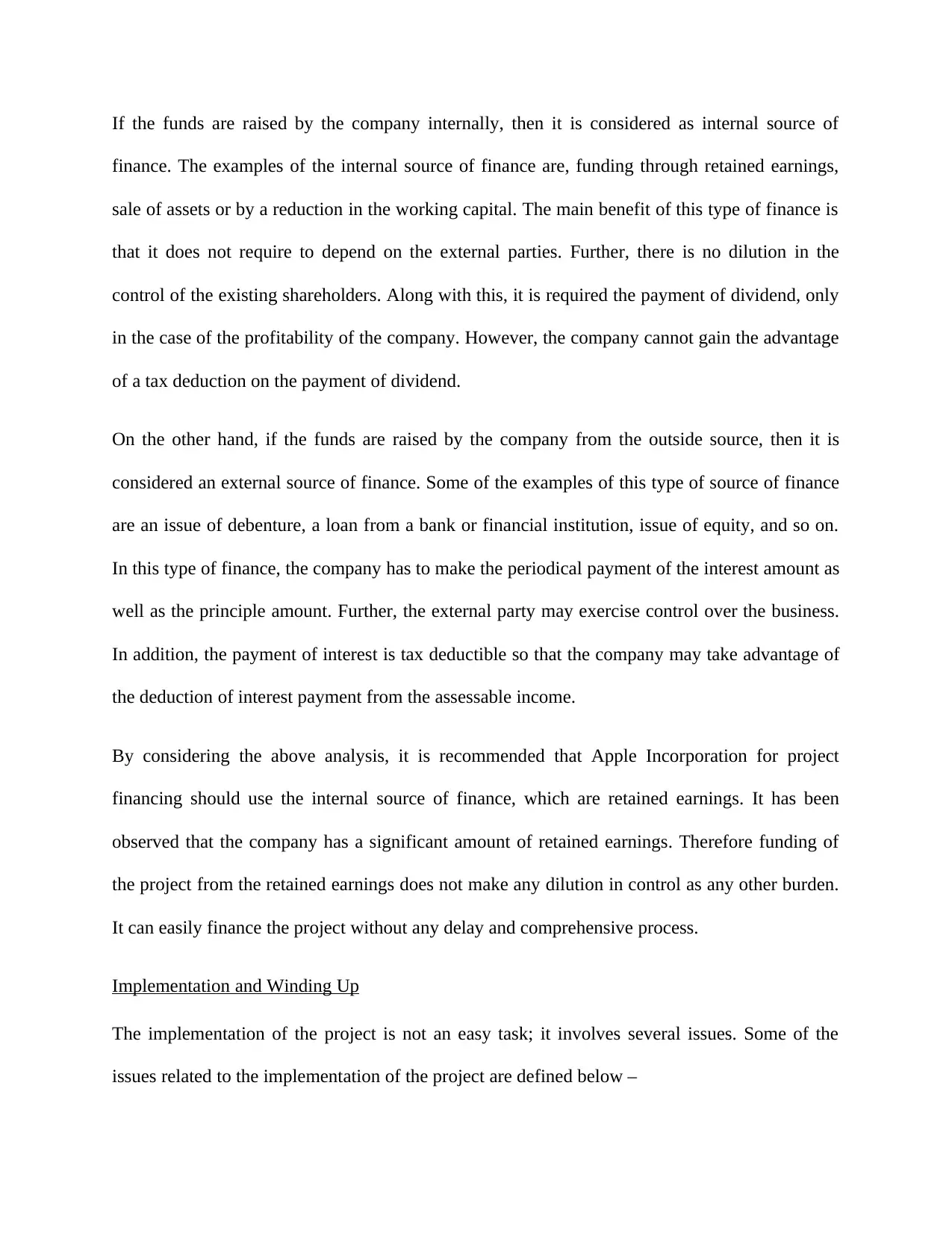
If the funds are raised by the company internally, then it is considered as internal source of
finance. The examples of the internal source of finance are, funding through retained earnings,
sale of assets or by a reduction in the working capital. The main benefit of this type of finance is
that it does not require to depend on the external parties. Further, there is no dilution in the
control of the existing shareholders. Along with this, it is required the payment of dividend, only
in the case of the profitability of the company. However, the company cannot gain the advantage
of a tax deduction on the payment of dividend.
On the other hand, if the funds are raised by the company from the outside source, then it is
considered an external source of finance. Some of the examples of this type of source of finance
are an issue of debenture, a loan from a bank or financial institution, issue of equity, and so on.
In this type of finance, the company has to make the periodical payment of the interest amount as
well as the principle amount. Further, the external party may exercise control over the business.
In addition, the payment of interest is tax deductible so that the company may take advantage of
the deduction of interest payment from the assessable income.
By considering the above analysis, it is recommended that Apple Incorporation for project
financing should use the internal source of finance, which are retained earnings. It has been
observed that the company has a significant amount of retained earnings. Therefore funding of
the project from the retained earnings does not make any dilution in control as any other burden.
It can easily finance the project without any delay and comprehensive process.
Implementation and Winding Up
The implementation of the project is not an easy task; it involves several issues. Some of the
issues related to the implementation of the project are defined below –
finance. The examples of the internal source of finance are, funding through retained earnings,
sale of assets or by a reduction in the working capital. The main benefit of this type of finance is
that it does not require to depend on the external parties. Further, there is no dilution in the
control of the existing shareholders. Along with this, it is required the payment of dividend, only
in the case of the profitability of the company. However, the company cannot gain the advantage
of a tax deduction on the payment of dividend.
On the other hand, if the funds are raised by the company from the outside source, then it is
considered an external source of finance. Some of the examples of this type of source of finance
are an issue of debenture, a loan from a bank or financial institution, issue of equity, and so on.
In this type of finance, the company has to make the periodical payment of the interest amount as
well as the principle amount. Further, the external party may exercise control over the business.
In addition, the payment of interest is tax deductible so that the company may take advantage of
the deduction of interest payment from the assessable income.
By considering the above analysis, it is recommended that Apple Incorporation for project
financing should use the internal source of finance, which are retained earnings. It has been
observed that the company has a significant amount of retained earnings. Therefore funding of
the project from the retained earnings does not make any dilution in control as any other burden.
It can easily finance the project without any delay and comprehensive process.
Implementation and Winding Up
The implementation of the project is not an easy task; it involves several issues. Some of the
issues related to the implementation of the project are defined below –
Paraphrase This Document
Need a fresh take? Get an instant paraphrase of this document with our AI Paraphraser
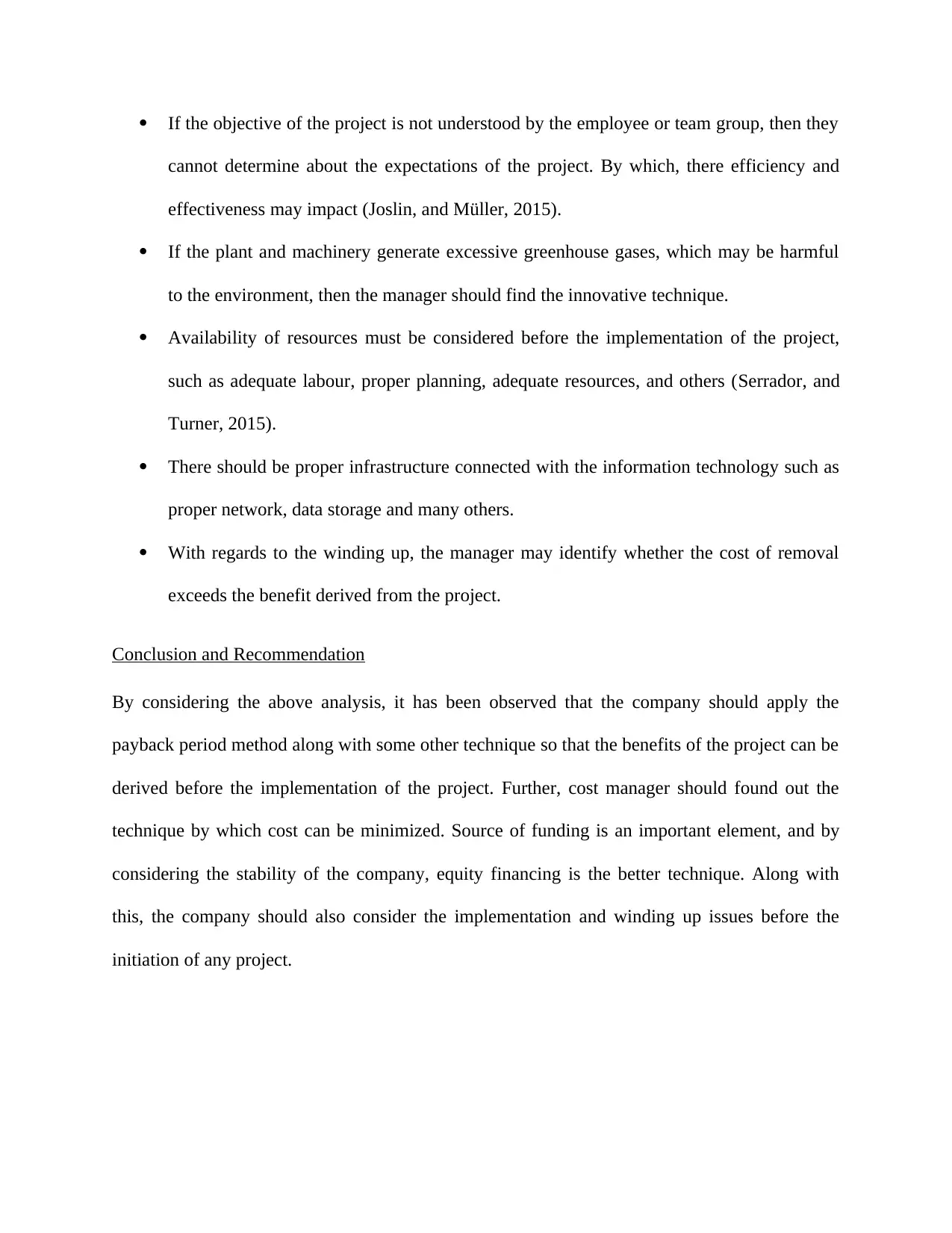
If the objective of the project is not understood by the employee or team group, then they
cannot determine about the expectations of the project. By which, there efficiency and
effectiveness may impact (Joslin, and Müller, 2015).
If the plant and machinery generate excessive greenhouse gases, which may be harmful
to the environment, then the manager should find the innovative technique.
Availability of resources must be considered before the implementation of the project,
such as adequate labour, proper planning, adequate resources, and others (Serrador, and
Turner, 2015).
There should be proper infrastructure connected with the information technology such as
proper network, data storage and many others.
With regards to the winding up, the manager may identify whether the cost of removal
exceeds the benefit derived from the project.
Conclusion and Recommendation
By considering the above analysis, it has been observed that the company should apply the
payback period method along with some other technique so that the benefits of the project can be
derived before the implementation of the project. Further, cost manager should found out the
technique by which cost can be minimized. Source of funding is an important element, and by
considering the stability of the company, equity financing is the better technique. Along with
this, the company should also consider the implementation and winding up issues before the
initiation of any project.
cannot determine about the expectations of the project. By which, there efficiency and
effectiveness may impact (Joslin, and Müller, 2015).
If the plant and machinery generate excessive greenhouse gases, which may be harmful
to the environment, then the manager should find the innovative technique.
Availability of resources must be considered before the implementation of the project,
such as adequate labour, proper planning, adequate resources, and others (Serrador, and
Turner, 2015).
There should be proper infrastructure connected with the information technology such as
proper network, data storage and many others.
With regards to the winding up, the manager may identify whether the cost of removal
exceeds the benefit derived from the project.
Conclusion and Recommendation
By considering the above analysis, it has been observed that the company should apply the
payback period method along with some other technique so that the benefits of the project can be
derived before the implementation of the project. Further, cost manager should found out the
technique by which cost can be minimized. Source of funding is an important element, and by
considering the stability of the company, equity financing is the better technique. Along with
this, the company should also consider the implementation and winding up issues before the
initiation of any project.
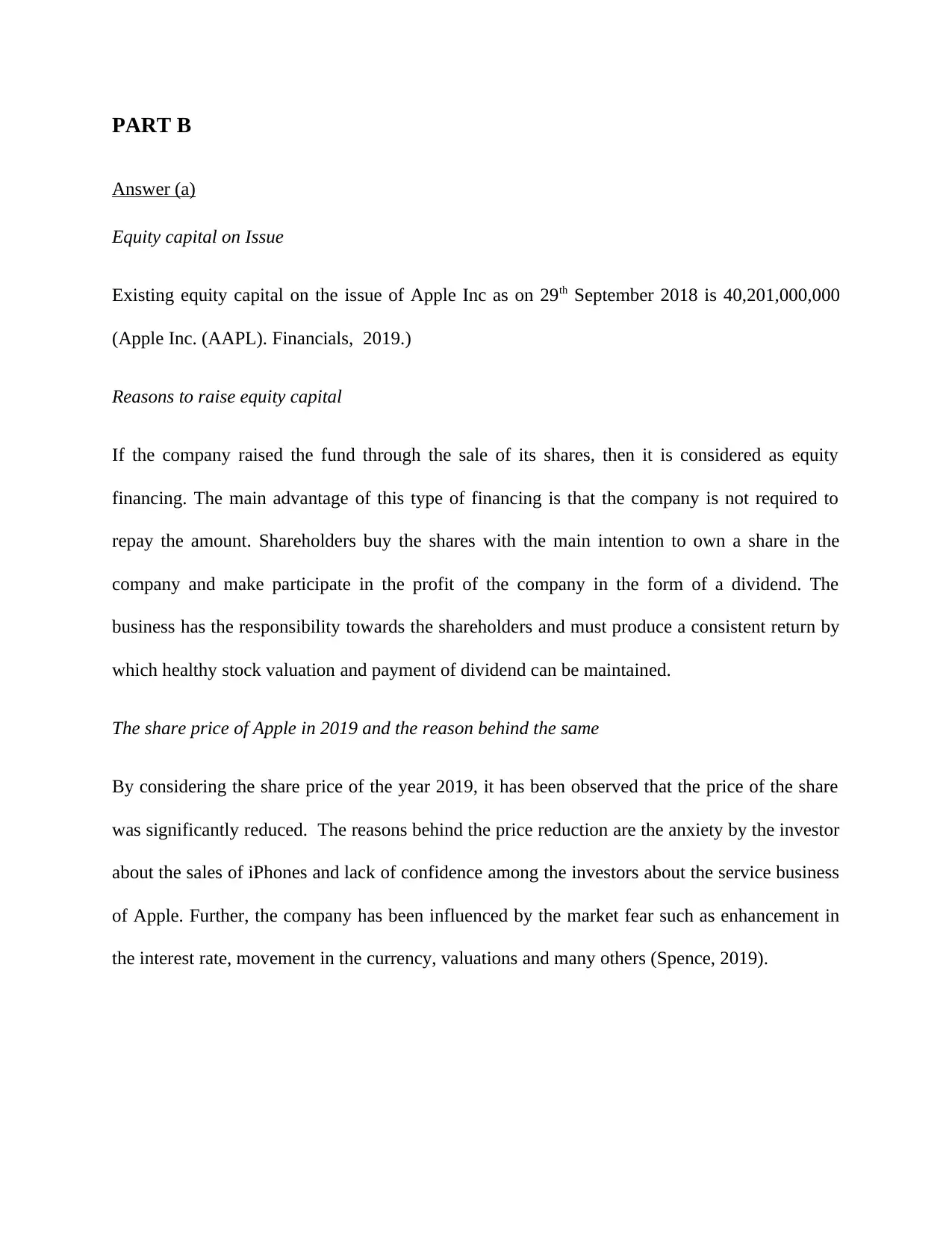
PART B
Answer (a)
Equity capital on Issue
Existing equity capital on the issue of Apple Inc as on 29th September 2018 is 40,201,000,000
(Apple Inc. (AAPL). Financials, 2019.)
Reasons to raise equity capital
If the company raised the fund through the sale of its shares, then it is considered as equity
financing. The main advantage of this type of financing is that the company is not required to
repay the amount. Shareholders buy the shares with the main intention to own a share in the
company and make participate in the profit of the company in the form of a dividend. The
business has the responsibility towards the shareholders and must produce a consistent return by
which healthy stock valuation and payment of dividend can be maintained.
The share price of Apple in 2019 and the reason behind the same
By considering the share price of the year 2019, it has been observed that the price of the share
was significantly reduced. The reasons behind the price reduction are the anxiety by the investor
about the sales of iPhones and lack of confidence among the investors about the service business
of Apple. Further, the company has been influenced by the market fear such as enhancement in
the interest rate, movement in the currency, valuations and many others (Spence, 2019).
Answer (a)
Equity capital on Issue
Existing equity capital on the issue of Apple Inc as on 29th September 2018 is 40,201,000,000
(Apple Inc. (AAPL). Financials, 2019.)
Reasons to raise equity capital
If the company raised the fund through the sale of its shares, then it is considered as equity
financing. The main advantage of this type of financing is that the company is not required to
repay the amount. Shareholders buy the shares with the main intention to own a share in the
company and make participate in the profit of the company in the form of a dividend. The
business has the responsibility towards the shareholders and must produce a consistent return by
which healthy stock valuation and payment of dividend can be maintained.
The share price of Apple in 2019 and the reason behind the same
By considering the share price of the year 2019, it has been observed that the price of the share
was significantly reduced. The reasons behind the price reduction are the anxiety by the investor
about the sales of iPhones and lack of confidence among the investors about the service business
of Apple. Further, the company has been influenced by the market fear such as enhancement in
the interest rate, movement in the currency, valuations and many others (Spence, 2019).
⊘ This is a preview!⊘
Do you want full access?
Subscribe today to unlock all pages.

Trusted by 1+ million students worldwide
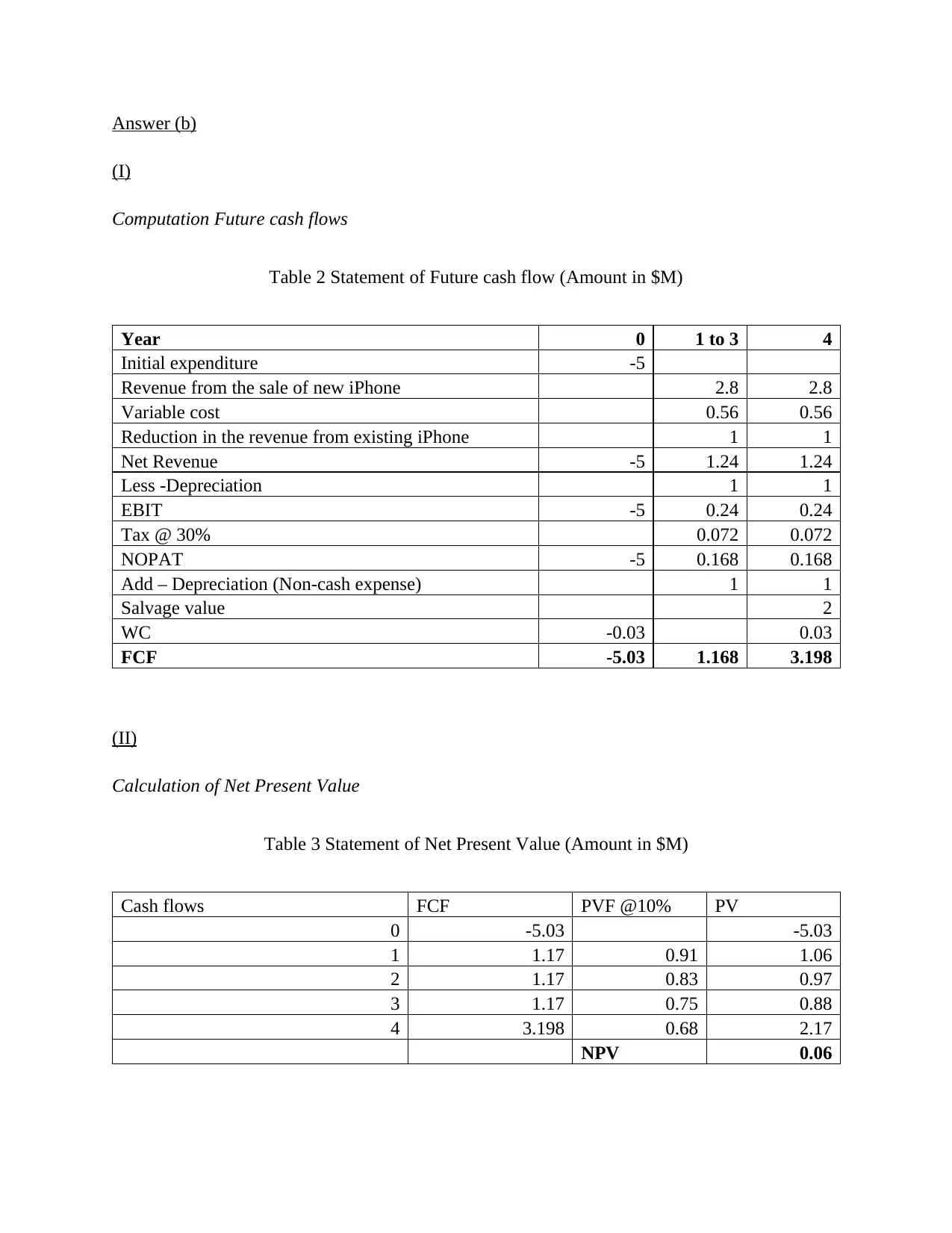
Answer (b)
(I)
Computation Future cash flows
Table 2 Statement of Future cash flow (Amount in $M)
Year 0 1 to 3 4
Initial expenditure -5
Revenue from the sale of new iPhone 2.8 2.8
Variable cost 0.56 0.56
Reduction in the revenue from existing iPhone 1 1
Net Revenue -5 1.24 1.24
Less -Depreciation 1 1
EBIT -5 0.24 0.24
Tax @ 30% 0.072 0.072
NOPAT -5 0.168 0.168
Add – Depreciation (Non-cash expense) 1 1
Salvage value 2
WC -0.03 0.03
FCF -5.03 1.168 3.198
(II)
Calculation of Net Present Value
Table 3 Statement of Net Present Value (Amount in $M)
Cash flows FCF PVF @10% PV
0 -5.03 -5.03
1 1.17 0.91 1.06
2 1.17 0.83 0.97
3 1.17 0.75 0.88
4 3.198 0.68 2.17
NPV 0.06
(I)
Computation Future cash flows
Table 2 Statement of Future cash flow (Amount in $M)
Year 0 1 to 3 4
Initial expenditure -5
Revenue from the sale of new iPhone 2.8 2.8
Variable cost 0.56 0.56
Reduction in the revenue from existing iPhone 1 1
Net Revenue -5 1.24 1.24
Less -Depreciation 1 1
EBIT -5 0.24 0.24
Tax @ 30% 0.072 0.072
NOPAT -5 0.168 0.168
Add – Depreciation (Non-cash expense) 1 1
Salvage value 2
WC -0.03 0.03
FCF -5.03 1.168 3.198
(II)
Calculation of Net Present Value
Table 3 Statement of Net Present Value (Amount in $M)
Cash flows FCF PVF @10% PV
0 -5.03 -5.03
1 1.17 0.91 1.06
2 1.17 0.83 0.97
3 1.17 0.75 0.88
4 3.198 0.68 2.17
NPV 0.06
Paraphrase This Document
Need a fresh take? Get an instant paraphrase of this document with our AI Paraphraser
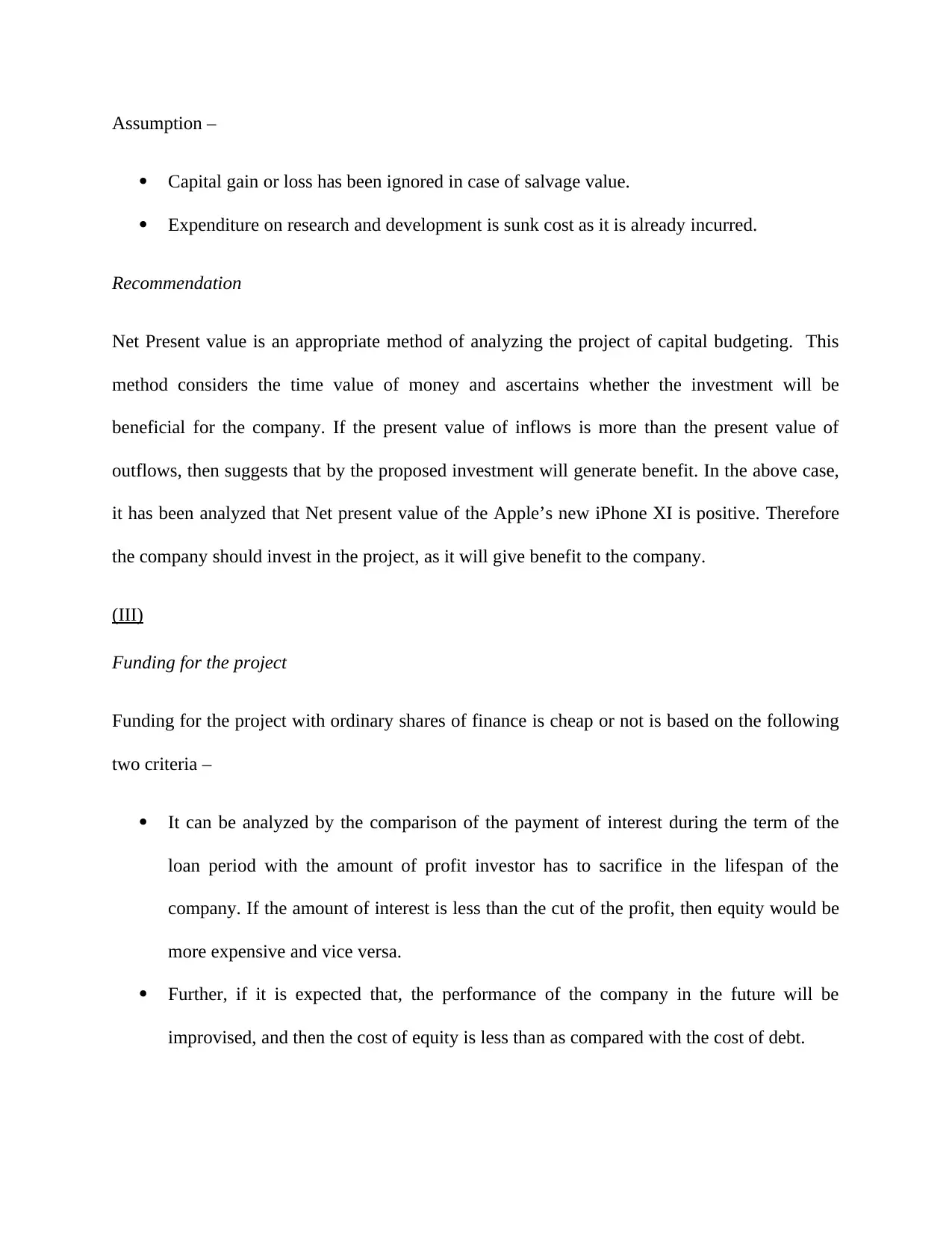
Assumption –
Capital gain or loss has been ignored in case of salvage value.
Expenditure on research and development is sunk cost as it is already incurred.
Recommendation
Net Present value is an appropriate method of analyzing the project of capital budgeting. This
method considers the time value of money and ascertains whether the investment will be
beneficial for the company. If the present value of inflows is more than the present value of
outflows, then suggests that by the proposed investment will generate benefit. In the above case,
it has been analyzed that Net present value of the Apple’s new iPhone XI is positive. Therefore
the company should invest in the project, as it will give benefit to the company.
(III)
Funding for the project
Funding for the project with ordinary shares of finance is cheap or not is based on the following
two criteria –
It can be analyzed by the comparison of the payment of interest during the term of the
loan period with the amount of profit investor has to sacrifice in the lifespan of the
company. If the amount of interest is less than the cut of the profit, then equity would be
more expensive and vice versa.
Further, if it is expected that, the performance of the company in the future will be
improvised, and then the cost of equity is less than as compared with the cost of debt.
Capital gain or loss has been ignored in case of salvage value.
Expenditure on research and development is sunk cost as it is already incurred.
Recommendation
Net Present value is an appropriate method of analyzing the project of capital budgeting. This
method considers the time value of money and ascertains whether the investment will be
beneficial for the company. If the present value of inflows is more than the present value of
outflows, then suggests that by the proposed investment will generate benefit. In the above case,
it has been analyzed that Net present value of the Apple’s new iPhone XI is positive. Therefore
the company should invest in the project, as it will give benefit to the company.
(III)
Funding for the project
Funding for the project with ordinary shares of finance is cheap or not is based on the following
two criteria –
It can be analyzed by the comparison of the payment of interest during the term of the
loan period with the amount of profit investor has to sacrifice in the lifespan of the
company. If the amount of interest is less than the cut of the profit, then equity would be
more expensive and vice versa.
Further, if it is expected that, the performance of the company in the future will be
improvised, and then the cost of equity is less than as compared with the cost of debt.
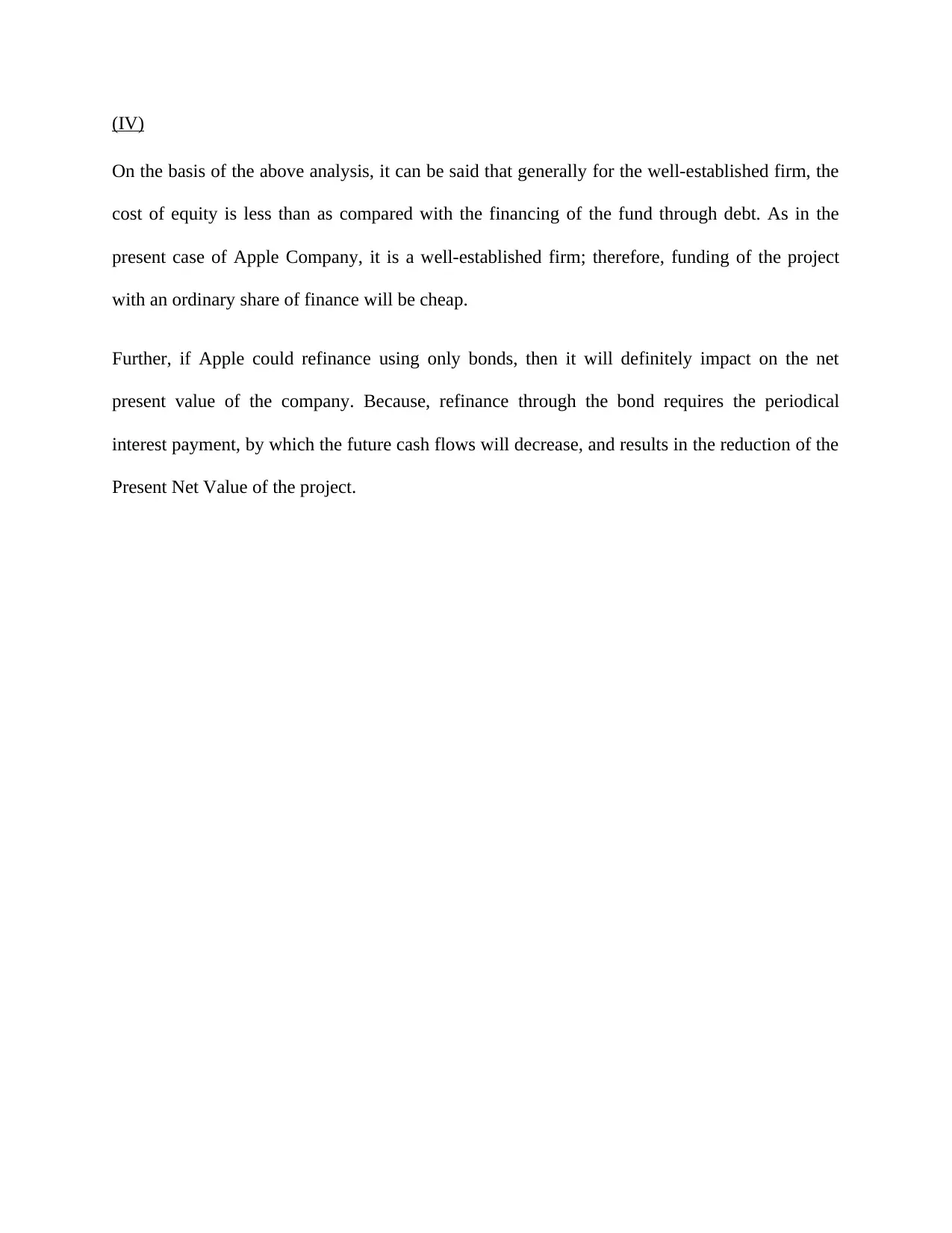
(IV)
On the basis of the above analysis, it can be said that generally for the well-established firm, the
cost of equity is less than as compared with the financing of the fund through debt. As in the
present case of Apple Company, it is a well-established firm; therefore, funding of the project
with an ordinary share of finance will be cheap.
Further, if Apple could refinance using only bonds, then it will definitely impact on the net
present value of the company. Because, refinance through the bond requires the periodical
interest payment, by which the future cash flows will decrease, and results in the reduction of the
Present Net Value of the project.
On the basis of the above analysis, it can be said that generally for the well-established firm, the
cost of equity is less than as compared with the financing of the fund through debt. As in the
present case of Apple Company, it is a well-established firm; therefore, funding of the project
with an ordinary share of finance will be cheap.
Further, if Apple could refinance using only bonds, then it will definitely impact on the net
present value of the company. Because, refinance through the bond requires the periodical
interest payment, by which the future cash flows will decrease, and results in the reduction of the
Present Net Value of the project.
⊘ This is a preview!⊘
Do you want full access?
Subscribe today to unlock all pages.

Trusted by 1+ million students worldwide
1 out of 14
Related Documents
Your All-in-One AI-Powered Toolkit for Academic Success.
+13062052269
info@desklib.com
Available 24*7 on WhatsApp / Email
![[object Object]](/_next/static/media/star-bottom.7253800d.svg)
Unlock your academic potential
Copyright © 2020–2025 A2Z Services. All Rights Reserved. Developed and managed by ZUCOL.




